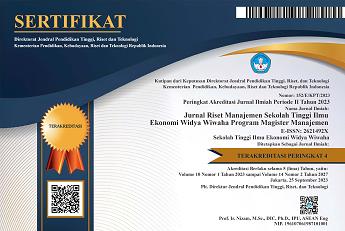KEPUTUSAN INVESTASI PERBANKAN NASIONAL PADA SUKUK INTERNATIONAL ISLAMIC LIQUIDITY MANAGEMENT (IILM)
DOI:
https://doi.org/10.32477/jrm.v5i1.40Keywords:
IILM Sukuk, Investment, Syariah Bank, Conventional Bank, IndexAbstract
This study aims to analyze the investment decision of banks and measures their investment preferences in IILM sukuk with IILM sukuk preference index. The investment decision is investigated from several factors, such as the structure of IILM sukuk, the currency used in the transaction IILM sukuk, tenors of IILM sukuk, covenants used in the transaction, marketability of IILM sukuk and IILM sukuk rating. This study also attempts to inform the features that can attract banks to invest in IILM sukuk. This study used quantitative method to calculate the index of banking investment decision on IILM sukuk. The result of this research explains that the index of banking investment decisions includes in the high category. The index investment decisions show a high index, but up to now banks have not invested in IILM sukuk. This needs in-depth education and socialization to banks related to IILM sukuk, and providing periodic information is really essential, so banks can get the latest information about IILM sukuk. Another factor that restricts bank investment in sukuk IILM is internal bank policies. Until now, banks still manage their funds by using investment instruments issued by the state or domestic sukuk. The recommendations for sukuk is related to IILM first appointment of primary dealers, and the institutions are expected to appoint IILM primary dealers located in Indonesia in order to facilitate buying and selling transactions of IILM sukuk. Furthermore, the selection of IILM tenor sukuk is expected to have miraculous tenor selection to meet the needs of banks. Further provision of rating is expected to not only IILM sukuk but also the standardized IILM institution to create more reliable institutions that are able to add the investors.
References
Abdullah, D. V. (2010), “Liquidity management in Institutions offering Islamic Financial Service”, IFSB at Second Islamic Financial Stability forum, 1-19.
Algifari (2003), Statistika Induktif untuk ekonomi dan Bisnis (2nd ed.), Yogyakarta: UPP AMP YKPN.
Bank Indonesia. (2014), Daftar Bank Devisa di Indonesia, www.bi.go.id, (Diunduh pada tanggal 5 November 2016)
Chermi, H., dan Jerbi, Y. (2015), “Sukuk as an attractive funding and investment in Tunisia”, Jurnal of Emerging economic and Islamic Reaserch, 13(1).
Creswell, J. (2013), Research Design Pendekatan Kualitatif, Kuantitatif, dan Mixed (3rd ed.), Yogyakarta: Pustaka Pelajar.
Dieye, A., dan Migdad, R. (2012), “Islamic Liquidity Mangement: Case Study Senegal (Islamic Bank of Senegal)”, INCEIF.
Fatwa Dewan Syariah Nasional Majelis Ulama Indonesia (2008), Fatwa DSN MUI No.72/DSN-MUI/VI/2008 tentang Surat Berharga Ijarah Sale and lease bac, www.dsnmui.or.id, (Diunduh 1 Januari 2017)
Fatwa Dewan Syriah Nasional Majelis Ulama Indonesia (2008), Fatwa DSN MUI No.71/DSN-MUI/VI/2008 tentang akad Sale and lease bac, www.dsnmui.or.id, (Diunduh 5 November 2016)
Fatwa Dewan Syriah Nasional Majelis Ulama Indonesia (2014), Fatwa DSN MUI No.95/DSN-MUI/VII/2014 tentang akad wakalah pada SBS, www.dsnmui.or.id, (Diunduh 5 November 2016)
IILM. Gambaran Umum Sukuk IIL, www.iilm.com, (Diunduh pada tanggal 10 Oktober 2016)
____. Press Release Re-issues Sukuk IILM Oktober (2016), www.iilm.com, (Diunduh tanggal 5 November 2016)
____. Primary Dealers, www.iilm.com, (Diunduh pada tanggal 10 Oktober 2016)
____. The Issuance Program, www.iilm.com, (Diunduh pada tanggal 10 Oktober 2016)
Ikatan Bankir Indonesia (2012), Manajemen Risiko 2, Jakarta: Gramedia Pustaka Utama.
____. (2012), Manajemen Risiko 3, Jakarta: Gramedia Pustaka Utama.
____. 2012), Manajemen Risiko 1, Jakarta: Gramedia Pustaka Utama.
International Islamic Liquidity Management Corporation (IILM), “Enhancing Global Islamic Liquidity Management”, Whitebox. Development of Financial sector.
Ismal, R. (2010), “Assessment of liquidity management in Islamic banking industry”, Emerald Journal of Humanomics, 3(2), 147-167.
Ismal, R. (2011), The Indonesian Islamic Banking theory and practices, Depok, Jawa Barat: Gramata publishing.
Karim, A. (2014), Bank Islam Analisis Fiqih dan Keuangan (5th ed), Depok: Raja Grafindo persada.
Karwowski, J. (2012), “Principle for Financial infrastructures”, Bank for International settlements and Internationalorganizaton of securities commision.
Kusuma, K. A., dan Silva, A. C. (2014), “Sukuk Markets a purposed approach for Development”, Policy working paper 7133, 1-33.
Muljawan, D., Yumanita, D., Anta taruna, A., dan Indah Astuti, R. (2014), “Peggunaan Sukuk IILM Sebagai Instrumen Investasi Dan Likuiditas Perbankan Syariah”, Working paper BI, 7.
Onal, M. I. (2013), “Islamic Liqudity Management: The way forward”, Afro Eurasian Studies, 2(1).
Otoritas Jasa Keuangan (2015), Peraturan Otoritas Jasa Keuangan No.42/ POJK.03/2015 tentang Kewajiban Pemenuhan Rasio Likuiditas Bagi Bank Umum, www.ojk.go.id, (Diunduh tangggal 15 Desember 2016)
Otoritas Jasa Keuangan. (2016), Statistik Perbankan Perbankan Indonesia Juni 2016, www.ojk.go.id, (Diunduh pada tanggal 5 November 2016)
Reuters, T. (2014), “Global Liquidity Management”, Roundtable On liquidity management, 1-85.
____. (2015), “Liquidity Managmenet Short term financial investment”, Roundtable On liquidity management, 1-40.
Riyadi, S. (2003), Banking Asset and Liability Mangement, Depok: Lembaga Penerbit Fakultas Ekonomi Universitas Indonesia.
Ryandono, M. (2008), Bursa Efek dan Investasi Syariah, Surabaya: Cahaya Amanah.
Sekaran, Uma (2006), Metode Penelitian untuk Bisnis, Buku 1, Jakarta: Salemba Empat.
Shiblaq, B. (2012, September 11), “Arend and Madernch in Islamic Finance News”
Sobol, I. (2013), “Liquidity Management Practicies in Islamic Banking”, 566- 576.
Soemitra, A. (2014), Masa Depan Pasar Modal Syariah Indonesia, Jakarta: Prenada Group.
Sugiyono. (2013), Metode penelitian Kuantitatif, Kualitatif, dan RandD (19th ed.), Bandung: Alfabeta.









